#ray lederer
Explore tagged Tumblr posts
Text
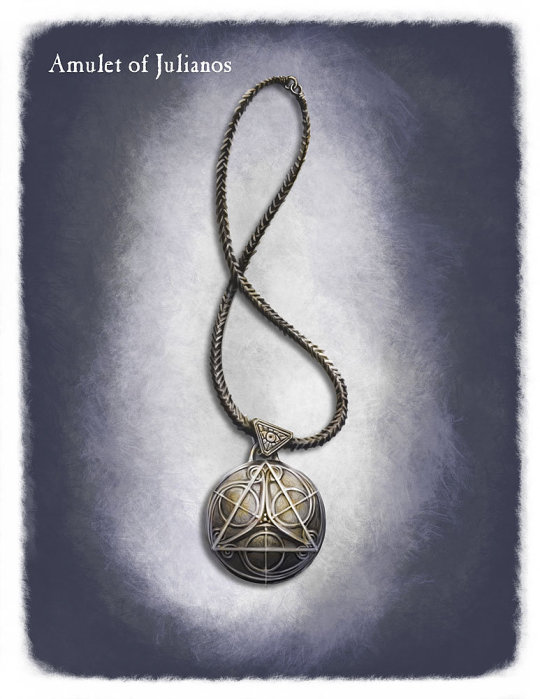
Amulet of Julianos
Concept Art for The Elder Scrolls V: Skyrim
Art by Ray Lederer
23 notes
·
View notes
Text

Downtown
Concept art for Fallout 4
Art by Ray Lederer
268 notes
·
View notes
Text

Frozen World
Concept art for Starfield
*Art credit unclear* I believe however this piece may be by Ray Lederer
23 notes
·
View notes
Text
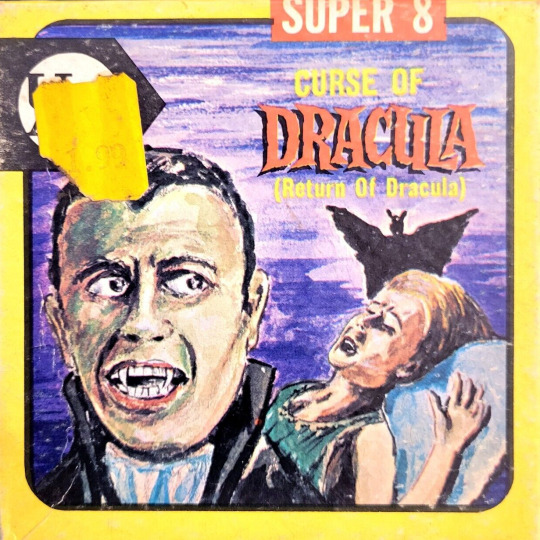
The Return of Dracula (1958) - Super 8mm
#the return of dracula#francis lederer#norma eberhardt#ray stricklyn#1950s horror#1950s movies#1958#paul landers#horror#super 8 mm
66 notes
·
View notes
Text


Concept Art of Nat, Piper Wright's sister in Fallout 4. The ushanka hat she wears in these concepts can be found inside her dresser at Publick Occurrences. Notably, she is also referenced as "Gnat" on the concept art pages. Created by artist Ray Lederer.
#fallout#fallout 4#fallout concept art#fallout 4 concept art#fallout series#fallout wiki#independent fallout wiki
45 notes
·
View notes
Text
appreciation post for Lise Mayer!! she co-wrote The Young Ones (and The Bachelor Boys book, additional material like when they did Comic Relief, etc), which is well known. but she also wrote for other things in the alternative comedy scene like Rik Mayall and Ben Elton's comedy tour (source: BBC Breakfast Time interview)! and, something I didn't know until recently: she co-wrote/wrote for Kevin Turvey! she's not credited in his television appearances, but see below for sources.
i really loved the podcast episode she did with Alexei Sayle about TYO, you gain a lot of insight into her perspective! she also mentions misogynistic treatment like being asked to go make tea when they were doing script readings, not getting invited to a big BBC party because it was presumed she'd be Rik's plus-one, and getting groped at the BBC bar. it pissed me off on her behalf and partly prompted this post.



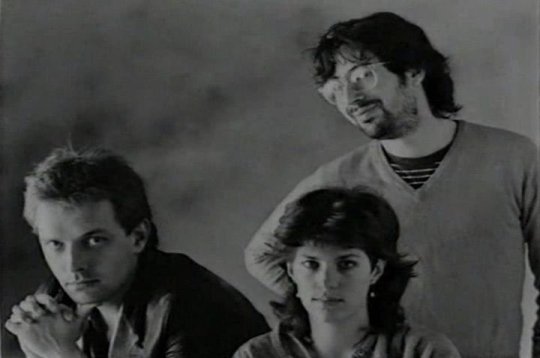
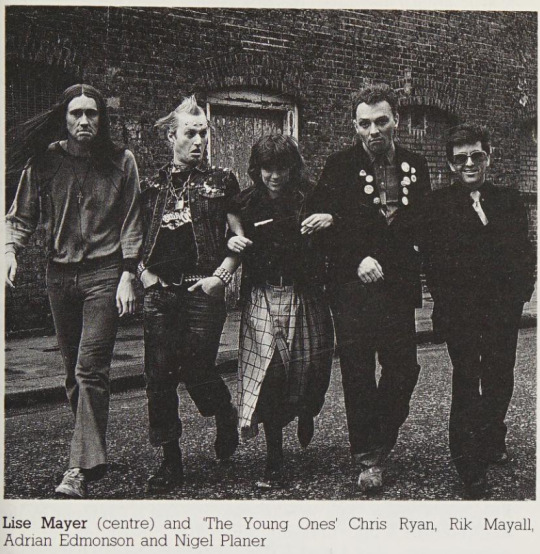
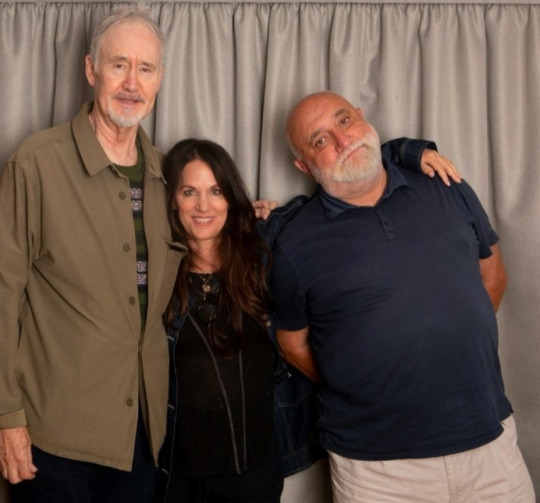
some specific accolades/accreditation/fun facts:
Rik crediting her with writing/conceiving the Kevin Turvey non-joke "All right, biting political satire: What do Lech Walesea and Menachem Begin have in common? They’ve both got foreign names! What do you mean it’s not funny?" (x)
Alexei Sayle in Thatcher Stole My Trousers crediting Lise with co-writing Turvey: "Lise was, like Linda for mine, a vital part of Rik’s career, co-writing both The Young Ones and Rik’s character Kevin Turvey..."
a 1987 source for Lise co-writing Turvey: "The assumption that women do not write comedy scripts was one with which Lise Mayer, co-writer of The Young Ones television series, has also had to contend. She started writing for Rik Mayall’s Kevin Turvey in the television series A Kick Up the Eighties..." (x)
Rowland Rivron (comedian who toured with The Comic Strip gang and lived with Rik and Lise) in What the f*** did I do last night?: "[Lise] also had the unenviable job of standing at the side of the stage when Rik was performing, and jotting down anything he said that was unscripted. If it got a laugh, it would be woven into the next night’s routine."
the only time i've ever seen a Rik Mayall/Ade Edmondson/Lise Mayer writing credit: for a poem called Distance which was collected in this anthology! Rik and Ade seem to have acted it out (or at least a version of it) in this 20th Century Coyote performance
Rik on Lise writing TYO: "‘She discovers different things: the comedy of embarrassment and awkwardness – she draws out the cheating and stealing that goes on in the house.’" (x) (Lise also says her "favorite comedy was always the comedy of embarrassment" in the Alexei Sayle podcast)
Rik: "... Lise Mayer wrote this great scene where I find a tampon in a handbag and it's my birthday party and I think it's a present because my character is Rick, who is such a git, he didn't know." (x)
Helen Lederer in Not That I'm Bitter, writing about being on The Young Ones: "[Lise] was known to be the brains behind it all, particularly the more surreal elements…"
she and Rik chose the bands (x)
Lise: “We’d have a table read at which point we’d discover that the script ran over an hour long, and then I’d have a sleepless night editing it.” Alexei: “You did that?” Lise: “Usually me, yeah…” (she later explains they'd present the script Monday and rehearsals were Tuesday, Wednesday-so she literally had one night to edit!) (x)
facts from the blu-ray commentary tracks:
Rick's yellow dungarees in Interesting were based off a picture of Lise in a similar pair
Lise wrote an essay about the tampon joke in Interesting so that the BBC didn't cut the scene (though they still edited it)
Paul Jackson (producer) credits Lise with arguing "you are seriously telling me that we cannot refer on television to something that happens to 50% of the population for about 30 years of their life? and we're not allowed to even refer to it" to make an executive back off about the tampon joke in a meeting
Lise came up with Neil's flowerpot covering in Nasty
Vyvyan/Vivian's name comes from Lise having lived in Vyvyan Terrace, Bristol
Lise thought of the cast switching costumes in Bambi (one of my favorite moments!!) (/end of commentary track facts)
this is guesswork, but i've seen Ben Elton and Rik Mayall's handwriting and i'm pretty sure the editing/handwriting on the bottom left on this script must be Lise's, which gives insight into what/how she wrote: (x)
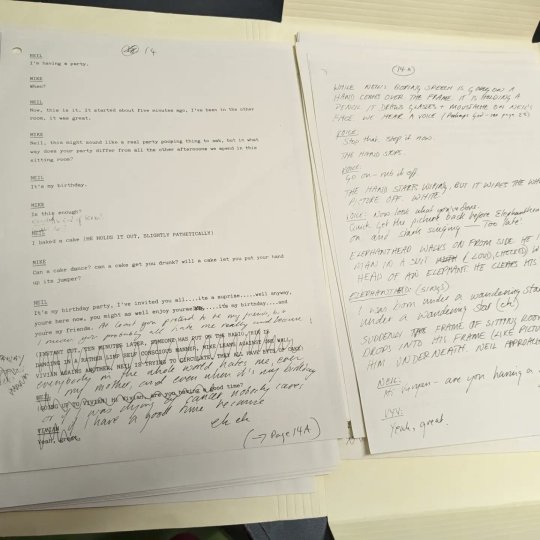
i feel like it's easy for people to overlook or minimize Lise's impact, something that happens to female creators far too often. i hate when women's identities are framed around their association to a man-girlfriend to Rik in this case-which was the norm whenever i saw Lise discussed in articles/books/online discussions about TYO. it's important to know she was a writer and co-creator with her own identity and (underappreciated) contributions. The Young Ones (and Kevin Turvey, and things we don't even know she goes uncredited for) would not have been the same—or wouldn't have even existed—without her!
#women in comedy are everything to me. lise was the one who did the typing to amalgamate the TYO scripts AND edited them down in 1 night...#women have to work so hard to prove their place in male dominated fields. she deserves her flowers!!#lise mayer#rik mayall#the young ones#kevin turvey#ben elton#britcom#in berserker! ade says vyvyan is named that because he and rik loved Vivian Stanshall#so i imagine lise gave the spelling? which is quite important i would say! just interesting to know the Full picture#also i reallyyy wanna know when Distance was actually written. it was collected in an anthology pubished in '84#but it very well couldve been written before (as other works in that book were written before 1984 as well)#basically im wondering if Lise contributed to 20th century coyote sketches?? i wouldnt be surprised bc she wrote a lot for rik
111 notes
·
View notes
Text
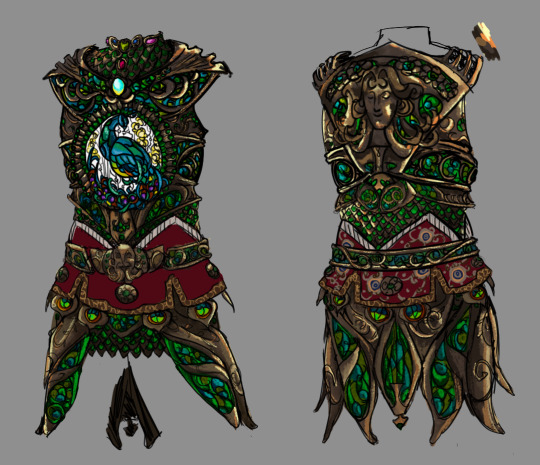
Glass Armor. First introduced in Morrowind as a High Elven design mass-produced for warriors in service to the Dark Elven god-king Vivec, a Gigeresque mass of neon green shards of volcanic glass set into elegant silver plates. It then gradually evolved into the more tame Ray Lederer design we all know and love from Skyrim. Both designs suit the High Elves of their respective games very well, but what sort of armors would they be constructing in their homeland? I wanted to design something beyond extravagant, purely decadent, calling to mind Art Nouveau sensibilities and even some influence from architecture, with the inlays resembling stained glass windows, and each individual plate resembling a flower petal or insect wing. Underneath the plates is a suit of scale mail, with each individual scale inlaid with a glass gem. I would love to see this design implemented into a mod as some sort of artifact from the High Elven homeland.
#concept art#concept design#prop design#armor#magic armor#armor design#character design#clothing design#morrowind#skyrim#summerset#elder scrolls#the elder scrolls#glass#malachite
302 notes
·
View notes
Text
The 30 Day Skyrim Challenge
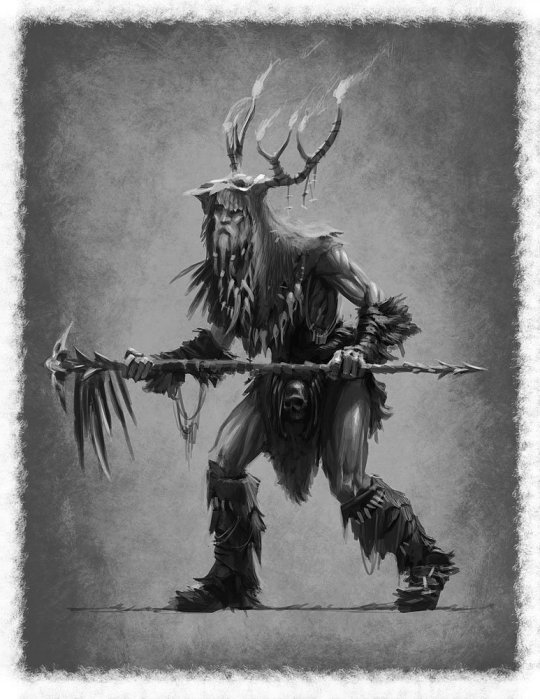
Day 13: Favorite Armor set? The armor of the old gods is my favorite, even though I never wear it.. Picture by Ray Lederer on ArtStation.
28 notes
·
View notes
Text
Wispmother - CR14 Undead
A powerful undead spirit of ghostly frost, based on the enemy from Elder Scrolls.

Artwork is official concept art from The Elder Scrolls V: Skyrim, by Ray Lederer on ArtStation, copyright Bethesda Softworks.
Among the folk tales from the northern reaches of the world are the Wispmother: ghostly women who lure unsuspecting travelers to their doom. Wispmothers take the form of elven spirits, wreathed in mist and decaying rags.
Wispmothers are not recent. They are the legacy of an ancient cult of necromancers, who thousands of years ago achieved eternal undeath by transforming their spirits into frost. No new wispmothers have been created in millennia, but destroying them is nearly impossible, and so they persist.
A victim is often initially drawn to the Wispmother by glowing, ghostly lights. Although initially passive, these creatures, frostwisps, later attack in tandem with her, distracting the victim and draining their energy. Wispmothers turn their slain victims into frostwisps, which they send out from their lairs to lure travelers to them.
I included descriptions of several of its feats, including two metamagic spell-like ability feats that aren't real feats and were never published by Paizo (although they did publish the equivalent actual metamagic feats for regular spells).
These creatures are based on the enemies of the same name from Skyrim, with their main feature being the frostwisps they control. Like basically all of my Pathfinder adaptations of creatures from other media, this isn't a direct conversion, it's just inspired by the Wispmother from Skyrim and includes some changes to make the fight more interesting.
Wispmother CR 14
The elven spirit seems to be made of animated frozen mist, wreathed in icy winds and decaying rags.
XP 38,400 NE Medium undead (cold, incorporeal) Init +11 Senses darkvision 60 ft.; Perception +25 Aura snowstorm (200 ft.)
DEFENSE
AC 25, touch 25, flat-footed 17 (+7 deflection, +7 Dex, +1 dodge) hp 184 (16d8+112) Fort +12, Ref +12, Will +17 Defensive Abilities incorporeal Immune cold, undead traits Weaknesses vulnerable to fire
OFFENSE
Speed fly 40 ft. (perfect) Melee incorporeal touch +19 (6d6 cold plus chilling touch plus energy drain) Special Attacks chilling touch, energy drain (1 level, DC 25), restore frost wisp
Spell-Like Abilities (CL 16th; concentration +16) Constant—blur 3/day—cone of cold (DC 22), ice storm, intensified studied thundering snowball (ranged touch +19, DC 18 (thundering), 10d6 cold damage) At will—dancing lights, frost glyphs (DC 24, see text), mirror image
STATISTICS
Str —, Dex 24, Con —, Int 21, Wis 24, Cha 25 Base Atk +12; CMB +19; CMD 37 Feats Dodge, Improved Initiative, Intensified Spell-like Ability (snowball), Mobility, Spell Penetration, Studied Spell-like Ability (snowball), Thundering Spell-like Ability (snowball), Intensified Spell-like Ability Skills Fly +26, Intimidate +26, Knowledge (arcana, dungeoneering, local, nature, planes, religion) +17, Perception +25, Sense Motive +15, Spellcraft +26, Stealth +26, Survival +10 Languages Aquan, Elven, Necril SQ bonded frostwisps
SPECIAL ABILITIES
Bonded Frostwisps (Ex) A wispmother has a number of frostwisps bonded to its service, which must stay within 500 ft. of the frostmother. A bonded frostwisp gains the Share Spells, Empathic Link, and Scry on Familiar abilities of a familiar, treating the wispmother as its master. A newly created frostmother typically has 1 bonded frostwisp, but can gain additional bonded frostwisps through its Turn to Frostwisp ability (see below), up to a maximum number of bonded frostwisps equal to half its hit dice.
If a wispmother is destroyed, its bonded frostwisps are instantly destroyed and cease being bonded to it.
Chilling Touch (Su) A wispmother's touch causes 6d6 cold damage. Whenever a creature takes cold damage from a wispmother's chilling touch, it must make a DC 25 Fortitude save to avoid being staggered by the supernatural cold for 1 round. This duration stacks. The save DC is Charisma-based.
After striking a target with its chilling touch attack on its turn, as a free action, a wispmother can attempt to dispels one magical affect effecting the target, as the targeted dispel option of dispel magic (CL 16th). The dispelling effect occurs even if the damage is negated (such as by energy resistance or immunity).
Dispel Synergy If a wispmother successfully dispels an ongoing magical effect on an opponent, that opponent takes a –2 penalty on saving throws against the wispmother's spells until the end of its next turn.
Frost Glyphs (Sp) As a standard action, as a spell-like ability, three times per day, a wispmother can place up to 8 glowing frost glyphs on surfaces she can see within medium range (typically 260 ft.). The frost glyphs must be placed at least 10 ft. apart from each other. Each frost glyph persists for 1 hour or until triggered. A frost glyph is triggered when any creature other than the frostmother or its bonded wisps moves within 10 ft. of it; the frostmother can designate other creatures that can safely approach the frost glyphs at the time of casting.
Upon being triggered, a frost glyph explodes in a 20-ft. burst of frost that deals 1d6 cold damage per 2 caster levels (typically 8d6) and slows target caught in the burst (as the slow spell) for 1 round. A successful Reflex save (typically DC 24) halves the damage and negates the slowing effect.
Glyphs cannot be affected or bypassed by such means as physical or magical probing, though they can be dispelled (doing so dispels all glyphs that were created with a single spellcast). Mislead, polymorph, and nondetection (and similar magical effects) can fool a glyph, though non-magical disguises and the like can’t. Read magic allows a creature to identify a frost glyph with a DC 17 Knowledge (arcana) check. Identifying the glyph does not discharge it and allows the creature to know the effect of the glyph.
Treat this as a 7th-level evocation [cold] spell. Spell resistance applies.
Rejuvenation (Su) In most cases, it’s difficult to destroy a wispmother through simple combat: the “destroyed” spirit restores itself in 1 year. Even the most powerful spells are usually only temporary solutions. If, after 1 year, the area where the wispmother is not below freezing, its rejuvenation is delayed until the area drops below freezing.
When a wispmother rejuvenates, it begins with only one bonded frostwisp; any others it had bonded to it before being destroyed are lost.
Restore Frostwisp (Su) As a one-round action, once every 1d3+2 rounds, a wispmother can restore all of its bonded frostwisps to full hit points and remove any harmful conditions from them, including frostwisps that have been destroyed.
Snowstorm (Su) A wispmother can cause itself to be surrounded by whirling blasts of snow, even in areas that wouldn’t allow for such weather, that comprise a 200-foot-radius spread. It can activate or deactivate this ability as a free action at the start of its turn. Within this area, the snowfall and wind gusts cause a -4 penalty on Perception checks and ranged attacks. The wind itself blows in a clockwise rotation around the wispmother, and functions as severe wind. A wispmother and its bonded wisps are unaffected by snowstorms or blizzards of any kind. Any effect that causes these winds to drop below severe (such as control weather or control winds) cancels the snowstorm effect entirely.
Studied Spell-like Ability Three times per day, when casting its snowball spell-like ability, a wispmother can enhance the spell as if with the Studied Spell metamagic. The wispmother attempts an appropriate Knowledge check based on that target’s creature type as it casts the spell. The DC for this check is equal to 20 + the creature’s CR based on its race and not including any class levels or template (a creature that is defined by class levels has an effective CR of 0 for this ability). If the wispmother succeeds, the snowball spell-like ability ignores any cold resistance the target has because of its race as well as any bonuses on saving throws against the spell granted by the target’s race (such as the bonus from a dwarf’s hardy ability or a halfling’s halfling luck ability). The snowball spell-like ability doesn’t ignore energy resistance or saving throw bonuses granted by other spells and effects. If the wispmother fails the Knowledge check, the snowball spell-like ability still has its normal effects.
Thundering Spell-like Ability Three times per day, when casting its snowball spell-like ability, a wispmother can enhance the spell as if with the Thundering Spell metamagic. If a creature takes damage from the snowball spell-like ability, it becomes deafened for 1 round; a successful Fortitude save (typically DC 18) negates the deafening effect.
Turn to Frostwisp (Ex) If a wispmother or one of her bonded frostwisps kills a living creature with at least 3 Intelligence, the creature turns into a frostwisp bonded to the wispmother after 24 hours. If the wispmother is destroyed during that time (even if it rejuvenates), or the dead creature is revived, the transformation into a frostwisp fails.
A wispmother can have a maximum number of bonded frostwisps equal to half its hit dice. If it creates another new bonded frostwisp at that point, it must choose one to release, which becomes a free-roaming uncontrolled undead (although it is not hostile to the frostmother).
7 notes
·
View notes
Text
Sci-Fi Saturday: The Thing From Another World

Week 28:
Film(s): The Thing From Another World (Dir. Christian Nyby, 1951, USA)
Viewing Format: Blu-Ray
Date Watched: 2022-02-04
Rationale for Inclusion:
As stated before, part of the point of this chronological survey of science fiction cinema was an excuse to revisit favorite films. This week we finally get to one of my partner and my preexisting favorites of the genre: The Thing From Another World (Dir. Christian Nyby, 1951, USA).
In part to differentiate it from the John Carpenter 1982 readaptation, this film is usually referred to as "Howard Hawks' The Thing" because the film is so full of the director's auteur tropes that it struck critics as inconceivable that he only acted as producer on the project. He did apparently contribute to the script, as did his frequent collaborator Ben Hecht, though sole screen credit for the adaptation of "Who Goes There?" by John W. Campbell is given to Charles Lederer, another regular Hawks collaborator.
Based on the rest of his filmography, credited director Christian Nyby seems to have only operated as director on a technical level, following the example of his mentor Hawks. Despite how the Cahiers du Cinema bros' auteur theory has been interpreted, not all directors are inherently auteurs. Just as some producers exercise authorship of their productions (sometimes to the consternation of directors), but not all. If/then logic and cult of personality can blind critics to how these dynamics vary from filmmaker to filmmaker.
All that to say, this film is "Howard Hawks' The Thing" in the same way that Destination Moon (Dir. Irving Pichel, 1950, USA) is "George Pal's Destination Moon." Hawks' preferences for content that define him as an auteur director flowed into him taking on the role of producer. I do think he left the mechanical chores of directing The Thing to Nyby, even as he was exerting great creative control.
At any rate, The Thing was the second film released in 1951 to focus on a crash-landed alien spaceship, roughly a month after The Man from Planet X (Dir. Edgar G. Ulmer, 1951, USA). Of the many sci-fi films released in 1951, including the iconic The Day the Earth Stood Still (Dir. Robert Wise, 1951, USA), The Thing proved to be the biggest moneymaker. Contemporary reviews were decidedly mixed, yet it has gone on to be one of the most referenced and lauded examples of the sci-fi genre of its era, eventually being added to the Library of Congress' National Film Registry in 2001.
Reactions:
As mentioned before, The Thing was a film that my partner and I had both seen before and liked, but watching it in the context of other genre films of its era gave us a deeper appreciation for it.
Due to a combination of auteur sensibilities, special effects limitations, and Production Code considerations, The Thing is only a loose adaptation of "Who Goes There?" No characters overlap between the two; the film swaps the South Pole for its northern counterpart; the spaceship crash has just happened, instead of occurring thousands of years ago; and the extraterrestrial they haul back to camp in a block of ice is not a shapeshifting mimic, but a carnivorous plant monster. Those familiar with John Carpenter's version, The Thing (Dir. John Carpenter, 1981, USA), will note that based on this list of changes alone, the later adaptation is closer to its source material than the 1951 version. Those who have read "Who Goes There?" and seen both films will confirm this fact.
The liberties taken with Hawks' The Thing may seem frustrating to people who want to watch a tighter adaptation of the source novella, but in and out of the context of 1950s sci-fi cinema, the Hawksian touches are what makes it a stand out film. The characters are all world-weary professionals who lived through World War II, and many have the sardonic sense of humor that comes from living through too many unprecedented events. The tough-talking, gorgeous and unapologetically funny Hawksian Woman is present in the form of Nikki Nicholson (Margaret Sheridan), Dr. Carrington's (Robert Cornthwaite) highly competent secretary. Unlike the clunky and stilted cardboard characters that populate The Man from Planet X, the characters have the personality, camaraderie, and senses of humor that are typical of Hawks' filmography and it makes the film a joy to watch.
In keeping with the characters being flashed out as realistic and expert people, to quote my partner, "nobody is a dumbass." Even as Dr. Carrington's attempts to better understand and communicate with The Thing (James Arness) may seem foolish, they are perfectly reasonable for an implicitly ace/aro scientist obsessed with gaining new knowledge whose ego gets the better of him. Dr. Carrigton explains during the dissection of the Thing's arm that the entity seems to be from a planet where plant life became dominant instead of animal life, yet nevertheless seems shocked when his attempts to communicate with the Thing are met with the same violence the alien showed the sled dogs earlier in the film. Either he had not connected that all animal life forms are merely lower order food to the Thing, or thought that his scientific brilliance and attempt at friendship would be well received regardless.
Scientists being treated as impractical, incorrect children in conflict with correct, military men of action has been cited by a recurring theme in sci-fi films of the 1950s by Peter Biskind in his book Seeing Is Believing: How Hollywood Taught Us to Stop Worrying and Love the Fifties. Given the nature of the Cold War politics, nuclear fears, and the United States pushing for heteronormativity after the gender role upsets necessary to engage in World War II, Biskind viewing sci-fi films like The Thing and Them! (Dir. Gordon Douglas, 1954, USA) as ideologically conservative is not an incorrect read. However, his way is not the only way to interpret these films; especially if you are not trying to make an overarching argument about a decade's worth of cinema.
Part of the appeal of The Thing is the same to me as Star Trek. My partner and I even commented on how the core plot (a militaristic group needing to protect a group of research scientists from a hostile alien) and character dynamics were proto-"Sass" Trek, as we often refer to the franchise, due to all Starfleet officers apparently having to meet a minimum sass requirement to serve. The less obvious narrative aspects The Thing has in common with Star Trek however is its respect for expertise, techno-babble, and practical, humanitarian underpinnings.
The first two are especially apparent amongst the team of scientists. Each one has discrete specializations, and is called upon to use them to interpret phenomena related to a crash landed extraterrestrial spacecraft, including its surviving passenger. In other sci-fi films, and not just during the 1950s, the scientist characters are often depicted as experts in all or multiple unrelated scientific disciplines. When such characters pop up, I am apt to quote Carlos the Scientist from an early episode of the podcast Welcome to Night Vale: "I'm a scientist. I study science."
The nature of expertise and experience translates into how the non-scientist characters are depicted and treat one another too. Captain Hendry (Kenneth Tobey) does not berate or question Tex (Nicholas Byron) the radio operator when the weather interrupts service, as some men of rank might a subordinate. Nikki's assessment of Dr. Carrington's personality and concerns about what the existence of extraterrestrials are taken seriously, not dismissed amid cocky sexism. Everyone clears the way when station nurse Mrs. Chapman (Sally Creighton) steps up to administer first aid to a victim of The Thing. The frustration that Scotty the journalist (Douglas Spencer) endures at not being able to put out his story about what's happening at the station is treated respectfully, and fully enabled when it becomes safe to do so. Despite frequently being positioned as opposing Captain Hendry, Dr. Carrington's knowledge or scientific findings are not questioned, just his lack of regard for the wellbeing of others. Individuals and their unique skill sets are prized, but so is community and general welfare, which is the dynamic that governs Star Trek crews, as well as any functional Dungeons & Dragons party.
The Thing is conservative in its plot, seeking to resolve itself by as close to a status quo as it can, and with the formation of a heterosexual union between Captain Hendry and Nikki. The dynamics in the universe where The Thing takes place are more egalitarian and good humored than the universe that Biskind delivered his criticism from. Although, The Thing is far from progressive: none of the scientists or officers are women, and the only non-white person in the film is Lee the Chinese cook (Lee Tung Foo). Still, its lack of explicit sexism and universal dignity allotted to its characters stands out relative to other films of the 1950s.
As iconic as the shot of the party investigating the downed ship forming a circle and the combat scenes with fire or electricity being used on the Thing are, it's the characters that endears The Thing to me so much as a movie. It's the quippy wingmen, kinky secretary and misanthrope lead scientist that draw me back to it again and again.
4 notes
·
View notes
Text
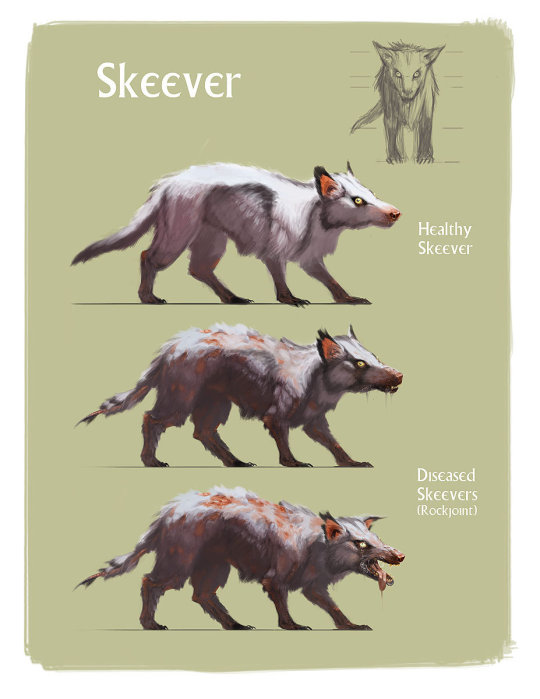
Skeever
Concept art for The Elder Scrolls V: Skyrim
Art by Ray Lederer
332 notes
·
View notes
Text
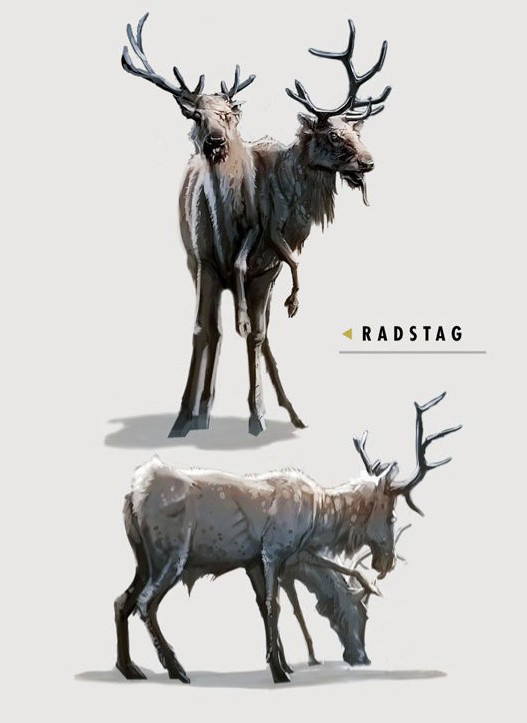
Radstag
Concept art for Fallout 4
Art by Ray Lederer
146 notes
·
View notes
Text

Desolate Wash
Key art for Starfield
Art by Ray Lederer
25 notes
·
View notes
Text


Though they didn't make it into Fallout 4, there are concepts for adapting the Centaurs of previous games into the new generation. Ultimately, they were replaced by Mutant Hounds designed by Ray Lederer.
51 notes
·
View notes
Text
Supporters of #NoHostageLeftBehind Open Letter to Joe Biden - Part 2/2
Gabe Turner
Gail Berman
Gary Barber
Genevieve Angelson
Gideon Raff
Grant Singer
Greg Berlanti
Guy Nattiv
Hannah Fidell
Hannah Graf
Harlan Coben
Harold Brown
Henrietta Conrad
Howard Gordon
Iain Morris
Imran Ahmed
Inbar Lavi
Jackie Sandler
Jake Graf
Jake Kasdan
Jamie Ray Newman
Jaron Varsano
Jason Fuchs
Jason Biggs & Jenny Mollen Biggs
Jason Segel
JD Lifshitz
Jeff Rake
Jen Joel
Jeremy Piven
Jesse Itzler
Jesse Sisgold
Jill Littman
Jody Gerson
Joe Hipps
Joe Quinn
Joe Russo
Joe Tippett
Joel Fields
John Landgraf
Jon Bernthal
Jon Glickman
Jon Liebman
Jonathan Baruch
Jonathan Groff
Jonathan Tropper
Jonathan Marc Sherman
Jonathan Steinberg
Jonathan Tisch
Josh Goldstine
Josh Greenstein
Josh Grode
Julia Lester
Julie Greenwald
Karen Pollock
Kelley Lynch
Kevin Kane
Kevin Zegers
Kitao Sakurai
KJ Steinberg
Laura Pradelska
Lauren Schuker Blum
Laurence Mark
Laurie David
Lee Eisenberg
Leslie Siebert
Leo Pearlman
Limor Gott
Lina Esco
Liz Garbus
Lizanne Rosenstein
Lizzie Tisch
Lorraine Schwartz
Lynn Harris
Lyor Cohen
Mandana Dayani
Maria Dizzia
Mara Buxbaum
Marc Webb
Marco Perego
Mark Feuerstein
Mark Shedletsky
Mark Scheinberg
Mathew Rosengart
Matt Lucas
Matt Miller
Matthew Bronfman
Matthew Hiltzik
Matti Leshem
Dame Maureen Lipman
Max Mutchnik
Maya Lasry
Meaghan Oppenheimer
Melissa Zukerman
Michael Ellenberg
Michael Aloni
Michael Green
Michael Rapino
Michael Weber
Mike Medavoy
Mimi Leder
Modi Wiczyk
Nancy Josephson
Natasha Leggero
Neil Blair
Neil Druckmann
Nicole Avant
Nina Jacobson
Noa Kirel
Noah Oppenheim
Noreena Hertz
Odeya Rush
Oran Zegman
Pasha Kovalev
Paul Haas
Paul Pflug
Peter Traugott
Rachel Riley
Rafi Marmor
Ram Bergman
Raphael Margulies
Rebecca Angelo
Rebecca Mall
Reinaldo Marcus Green
Rich Statter
Richard Kind
Rick Hoffman
Rick Rosen
Robert Newman
Rob Rinder
Roger Birnbaum
Roger Green
Rosie O'Donnell
Ryan Feldman
Sam Trammell
Sarah Baker
Sarah Bremner
Sarah Treem
Scott Tenley
Seth Oster
Scott Braun
Scott Neustadter
Shannon Watts
Shari Redstone
Sharon Jackson
Shauna Perlman
Shawn Levy
Sheila Nevins
Simon Sebag Montefiore
Simon Tikhman
Skylar Astin
Stacey Snider
Stephen Fry
Steve Agee
Steve Rifkind
Susanna Felleman
Susie Arons
Todd Lieberman
Todd Moscowitz
Todd Waldman
Tom Freston
Tom Werner
Tomer Capone
Tracy Ann Oberman
Trudie Styler
Tyler James Williams
Vanessa Bayer
Veronica Grazer
Veronica Smiley
Whitney Wolfe Herd
Will Graham
Yamanieka Saunders
Yariv Milchan
Ynon Kreiz
5 notes
·
View notes
Text
I ran out of queue again, so today's entry for MST3Knitathon, knitting through the top 100 episodes of MST3K from top to bottom, will be posted late as soon as I finish writing it:
67. Episode 508 Operation Double 007
(Note: this one is listed in the Gizmoplex under the alternate title Operation Kid Brother, for what I assume are copyright reasons)
Content Warning: Some brown face as the protagonist disguises himself as a blind Arab man to sneak into a factory that mysteriously only employs blind people. Also, one of the villains is coded as an evil lesbian
Summary: We have another 1960s spy movie, this one the most blatant James Bond rip-off yet. Neil Connery, Sean Connery's real life brother, plays Dr. Connery: a lip-reading polyglot plastic surgeon, martial arts expert, competitive archer, and hypnotist who is dragged into a spy caper against his will when a secret criminal organization kidnaps one of his patients, who was also the fiance of his recently murdered former hypnotism student. The actual actress who played Moneypenny and the actual actor who played M want to recruit him for a mission with their coyly unnamed spy agency, believing that the kidnapped girl's dead fiance gave her secret information under hypnosis that Dr. Connery can retrieve by putting her in a similar state, and they have no problem giving him clearance because his coyly unnamed brother is their best agent. (Incidentally, I am not a lawyer at all, much less a British one, but I don't think that ordering a reluctant doctor to work with British Intelligence until further notice is something the Minister of Health should be able to do.) It's off to a low-rent Bond adventure, with a low-rent Bond song, bombastic musical theme,exotic locations, spy gagets, undercover shenanigans, fancy parties, Bond girls, wild costumes, and fight scenes, including a fun sequence when the bad guys have used secret tech to turn off all machines in the world and the good guys must fight them on horseback with bows and arrows. Fun! (But not very good.)
MST3K Lore or Notable Moments: 1) Joel and Dr. F both step back from the invention exchange, as Dr. F wants to cheer a recently depressed Frank up by letting him present his invention of leder-hose-en (laderhosen pants with an attached garden hose), and Joel lets Crow show off his attempt to improve the reputation of environmentally crucial vultures by making a vulture version of a dippy bird. 2) Torgo finally arrives at Deep 13 with the Mads drink order, having gone back to the pizza place for it in episode 424 at the end of last season (we will get there eventually)
What do I think about its place on the list? After a couple of duds, this episode is so much fun! The movie is a wild, colorful spectacle that would probably be fun to watch on its own (though you would be laughing at it, not with it, the entire time), the riff is so good that the nun jokes from the hospital abduction scene is one of the sequences used in advertisements for the various 24-hour MST3K streams, and I outright cackled in delight when Torgo showed up. Even though I'm looking ahead and the next two episodes are also both bangers, I'm tempted to move this one up on the list anyway. However, I've heard this episode and Danger, Death Ray! (voted at number 52) mentioned as the top contenders for their best spy caper episode, and since I have no memories of Danger, Death Ray! at all, I want to reserve judgement until I get to that one. If you have not seen this episode yet, though, definitely watch it - it's a treat!
Tune in Wednesday for: Number 66 Episode 803 The Mole People
1 note
·
View note